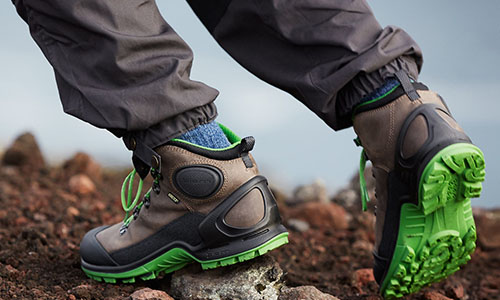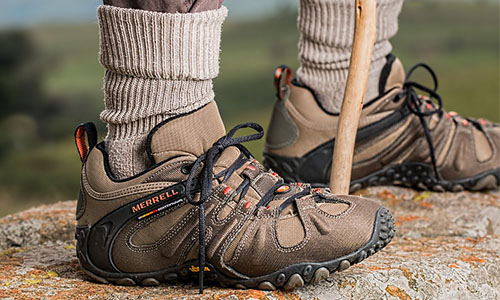Choosing between hiking boots and trail shoes
Author

Chris shares his passion for cycling, hiking, skiing, and climbing from Buxton, in the Peak District. As a blogger for Outdoor Look, Chris shares outdoor tips and indoor tricks to help you get the most out of your time spent outside. When he's not out adventuring he's making videos or trying to keep up with his 4-year-old son.
 Different people have different choices. Many people feel comfortable in hiking boots while the rest of us prefer trial-running shoes. You need to take into account the terrain, the weather, and the conditions on offer.
Different people have different choices. Many people feel comfortable in hiking boots while the rest of us prefer trial-running shoes. You need to take into account the terrain, the weather, and the conditions on offer.
Before going outdoors, you will need to know more about the terrain of where you will walk or run. Is it a rocky terrain? On many occasions, the turfs you need to cross can be uneven, which would further put your boots to the test.
Before hitting the slope, you need to have a closer look at the terrain where you’d be walking or running.
On many occasions, wearing hiking boots are an ideal way to protect the feet while walking on treacherous terrains. These boots are heavier than normal boots, and are therefore, not recommended for undertaking long walks that are most likely to turn into a run.
The trail runner shoes offer a greater degree of comfort and flexibility on hiking trails than all other boots. These boots are ideal for undertaking brisk walks, but when it comes to providing underfoot protection while making your way through rocky terrains, these boots aren’t of much help.
Hiking boots and trail-running shoes: The striking differences
The first and the foremost difference between hiking boots and trail running shoes is that hiking boots cover the ankle to offer a greater degree of stability. Many hikers like to have their ankles covered, especially while making their way across craggy terrains.
Now comes the downside, these shoes might hamper the speed of movement and the ability to run because of sheer lack of ankle flexibility.
Moving further, these boots have quite a few variations, from lightweight summer boots to stiff and highly durable winter walking boots. Swapping winter walking boots for trainers isn’t a good idea, but a summer boot can easily be swapped with a trail runner if the conditions allow.
 Also, hiking boots are waterproof. The ankle prevents water from getting inside and these boots sport a waterproof lining of some kind. The best waterproofing can be seen in leather boots. The soles of hiking boots can effortlessly withstand the rigours and vigors of everyday use.
Also, hiking boots are waterproof. The ankle prevents water from getting inside and these boots sport a waterproof lining of some kind. The best waterproofing can be seen in leather boots. The soles of hiking boots can effortlessly withstand the rigours and vigors of everyday use.
While trail runners also have grippy soles, when compared to trainers, they aren’t robust and lack the sole of a hiking boot. You’ll find that the soles of these boots are made using grips of different levels depending on the conditions as well as the terrain.
Trail running shoes and their striking features
These are much lighter than the hiking boots and lack ankle support. These shoes offer freedom of movement. They are ideal for brisk running.
You can wear trail running shoes during summer, but you need to take a comprehensive a good look at the soles and the uppers in order to make sure they are suitable for the purpose. Some trail shoes come with grippy soles for running in the mountains. Also, there are those with stiff or more flexible soles depending on where you want to run or walk.
All in all, the best way to choose the ideal pair of shoes is to take the terrain that you’d be walking on into consideration. You also need to keep an eye on the weather. Then think about whether you will be mainly hiking or planning to hike and run.
Author

Chris shares his passion for cycling, hiking, skiing, and climbing from Buxton, in the Peak District. As a blogger for Outdoor Look, Chris shares outdoor tips and indoor tricks to help you get the most out of your time spent outside. When he's not out adventuring he's making videos or trying to keep up with his 4-year-old son.
- Speed Up Your Post-Hike Recovery with These 6 Essential Tips
- Cycling through Tranquil Roads and Coastal Views on the Isle of Wight
- The Essential Guide to Hiking Safety: 5 Tips Every Hiker Should Know
- Run Smart, Run Strong: Your Guide to Injury-Free Running
- Embrace Biking: Essential Tips for Beginners
Categories
- Sport (28)
- Product Reviews (3)
- Team Outdoor Look (7)
- Mike Wild (2)
- Mike Payton (2)
- Suse Hammond-Pears (3)
- Snowboarding (12)
- Latest Offers (105)
- Shop Talk (1)
- Competitions (7)
- Walking (413)
- Lifestyle Fashion (8)
- Travel (86)
- Kit Guides (176)
- Workwear Clothing (6)
- Safety Workwear (4)
- Health/Fitness (289)
- Skiing (91)
- Great Outdoors (1316)
- Cycling (92)
- January 2025
- December 2024
- November 2024
- October 2024
- September 2024
- August 2024
- July 2024
- June 2024
- May 2024
- April 2024
- March 2024
- February 2024
- January 2024
- December 2023
- November 2023
- October 2023
- September 2023
- August 2023
- July 2023
- June 2023
- May 2023
- April 2023
- March 2023
- February 2023
- January 2023
- December 2022
- November 2022
- October 2022
- September 2022
- August 2022
- July 2022
- June 2022
- May 2022
- April 2022
- March 2022
- February 2022
- January 2022
- December 2021
- November 2021
- October 2021
- September 2021
- August 2021
- July 2021
- June 2021
- May 2021
- April 2021
- March 2021
- February 2021
- January 2021
- December 2020
- November 2020
- October 2020
- September 2020
- August 2020
- July 2020
- June 2020
- May 2020
- April 2020
- March 2020
- February 2020
- January 2020
- December 2019
- November 2019
- October 2019
- September 2019
- August 2019
- July 2019
- June 2019
- May 2019
- April 2019
- March 2019
- February 2019
- January 2019
- December 2018
- November 2018
- October 2018
- September 2018
- August 2018
- July 2018
- June 2018
- May 2018
- April 2018
- March 2018
- February 2018
- January 2018
- December 2017
- November 2017
- October 2017
- September 2017
- August 2017
- July 2017
- June 2017
- May 2017
- April 2017
- March 2017
- February 2017
- January 2017
- December 2016
- November 2016
- October 2016
- September 2016
- August 2016
- July 2016
- June 2016
- May 2016
- April 2016
- March 2016
- February 2016
- January 2016
- December 2015
- November 2015
- October 2015
- September 2015
- August 2015
- July 2015
- June 2015
- May 2015
- April 2015
- March 2015
- February 2015
- January 2015
- December 2014
- November 2014
- October 2014
- September 2014
- August 2014
- July 2014
- June 2014
- May 2014
- April 2014
- March 2014
- February 2014
- January 2014
- December 2013
- November 2013
- October 2013
- September 2013
- August 2013
- July 2013
- June 2013
- May 2013
- April 2013
- March 2013
- February 2013
- January 2013
- December 2012
- November 2012
- October 2012
- September 2012
- August 2012
- July 2012
- June 2012
- May 2012
- April 2012
- March 2012
- February 2012
- January 2012
- December 2011
- November 2011
- October 2011
- September 2011
- August 2011
- May 2010
- April 2010
- March 2010
- February 2010
- January 2010
- November 2009
- October 2009
- September 2009
Submit a Comment